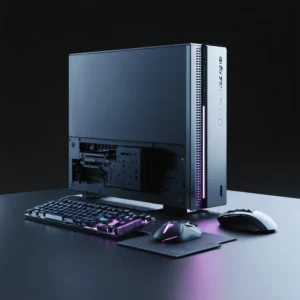
Introduction – A New Dawn for Half‑Life 2
More than two decades since its original release, Valve’s iconic Half‑Life 2 has continued to captivate gamers around the world. With the advent of modern technologies such as ray tracing, the renowned title has undergone a remarkable transformation. The Half‑Life 2 RTX mod represents a fusion of classic gameplay with state‑of‑the‑art graphical enhancements, demonstrating the potential that modern hardware holds for revitalizing beloved video games. This advancement is not merely a cosmetic overhaul but a substantial upgrade that brings contemporary graphical fidelity—featuring dynamic lighting effects, improved textures, and enhanced in‑game assets—to a timeless narrative. With the resurgence of interest in immersive experiences, the mod has reinvigorated the gaming community and set new standards in the integration of advanced visualization techniques into older titles.
The Technological Leap – From Legacy to Cutting‑Edge
Ray Tracing and Lighting Effects
The cornerstone of the RTX transformation lies in the utilization of ray tracing technology, which simulates the behavior of light with unprecedented realism. In the RTX‑enhanced version, each beam of light, shadow, and reflection is meticulously computed, creating an environment where every surface interaction is believable. The dramatic improvements in lighting contribute to a more immersive game world where atmospheric conditions play a prominent role in narrative tension.
Path Tracing and Advanced Rendering Techniques
Beyond standard ray tracing, path tracing ensures that global illumination is realistic across complex environments. This method computes indirect lighting effects and multiple bounces of light, significantly enriching scenes such as the eerie corridors of Ravenholm. As a result, in‑game environments exhibit a depth and complexity that were previously unattainable in the aging engine of Half‑Life 2.
Enhanced In‑Game Assets – Breathing New Life into Familiar Territory
Polygons, Textures, and Detail
One of the most striking aspects of the upgrade is the overhaul of in‑game assets. The mod introduces new assets with increased polygon counts and superior texture resolutions, ensuring that every surface—from the grimy walls of dystopian environments to the intricate details of character models—appears more lifelike. This attention to detail elevates the gaming experience, providing both nostalgia and novelty for players.
Immersive Environments and Architectural Revamps
The combined efforts of talented modders have led to a revitalization of iconic locations within the game. In the demo version, only Ravenholm has been fully upgraded, but the ambitious plans to enhance the entirety of Half‑Life 2 are already in motion. This collective project signifies how community‑driven initiatives can join forces with technological advancements to create a product that honors the past while moving decisively into the future.
System Performance and Future Considerations
Balancing Enhanced Graphics with Optimal Performance
Adopting such modern technologies means that players will see increased demands on their hardware. The upgraded version is tailored for the latest RTX graphics cards, and features such as DLSS, Multi Frame Generation, and Neural Radiance Caching are employed to maintain a smooth and enjoyable gaming experience. This balance between cutting‑edge visuals and performance optimization is crucial, especially when considering systems that still rely on older components.
Performance Recommendations:
- Ensure that your system meets the requirements for RTX 50‑series GPUs or above.
- Utilize the latest drivers and updates to take full advantage of DLSS and other rendering technologies.
- Monitor system performance closely when enabling additional graphical features.
Detailed Comparison of Original vs. RTX‑Enhanced Graphics
A closer examination of the graphical improvements reveals a remarkable transformation. The following table outlines some critical differences between the original graphics of Half‑Life 2 and the RTX‑enhanced version:
| Aspect | Original Graphics | RTX‑Enhanced Graphics |
|---|---|---|
| Lighting | Pre‑computed static lighting | Dynamic ray traced lighting with realistic shadows |
| Textures | Low‑resolution textures with minimal detail | High‑resolution, detailed textures showcasing material properties |
| Environment | Standard in‑game models and assets | Newly designed assets with increased polygon counts and enhanced realism |
| Overall Performance | Optimized for older hardware | Requires modern GPU architecture with advanced features |
Community Impact and Business Implications
Empowering Community‑Driven Innovation
The creation of the Half‑Life 2 RTX mod is a testament to the power of community collaboration and innovation. It highlights how dedicated modder teams can develop industry‑standard graphics enhancements without direct affiliation with major studios like Valve. This democratization of game enhancement tools encourages independent developers and modders to explore new avenues in interactive design, directly influencing mainstream gaming trends.
Business Insights and the Future of Game Development
For businesses in the gaming industry, the RTX‑enhanced modification of an established title like Half‑Life 2 offers valuable insights. It demonstrates that even mature game franchises can benefit from the injection of modern technological advancements. Here are several key business implications:
- Extended Product Lifecycles: Upgrading classic titles can open new revenue streams and keep longstanding franchises relevant.
- Innovation through Collaboration: Partnering with independent developers or modder communities can infuse fresh, creative ideas into venerable IPs.
- Market Advantages through Visual Fidelity: Leveraging cutting‑edge graphics technology can provide a competitive edge by offering a visually superior product.
- Customer Engagement: Mods and upgrades create additional layers of engagement, fostering a loyal community that supports the product long after its initial release.
Conclusion – A Vision for the Future
The Road Ahead for Half‑Life 2 RTX
The Half‑Life 2 RTX mod not only redefines the visual and immersive quality of a classic game but also sets a precedent for future projects. By merging historical gameplay with innovations in rendering technology, the mod has reimagined what is possible in the realm of graphics enhancement. As the project continues to expand beyond the Ravenholm section, both gamers and industry professionals are keenly observing its evolution.
Final Thoughts on Innovation and Legacy
This transformation reinforces the idea that timeless classics can and should be revisited with fresh perspectives. By addressing the challenges of integrating modern graphics into older game infrastructures, the project paves the way for similar upgrades across a variety of established titles. The combination of advanced graphics, community involvement, and business strategy creates a dynamic model that the gaming industry may increasingly adopt in the coming years.
In summary, the RTX‑enhanced version of Half‑Life 2 is more than just a nostalgic trip down memory lane; it is a bold step toward merging past and future. For both industry veterans and new players, it is a clear demonstration of what can be achieved when technology meets creativity. As companies and developers continue to innovate, the evolution of game graphics will remain one of the most exciting frontiers in digital entertainment.







